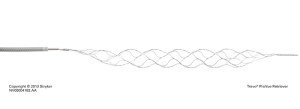 The US Food and Drug Administration has cleared the use of the Trevo clot retrieval device to treat certain stroke patients up to 24 hours after symptom onset, expanding the device’s indication to a broader group of patients. This device is cleared for use as an initial therapy for strokes due to blood clots (also known as an acute ischemic stroke) to reduce paralysis, speech difficulties and other stroke disabilities and only as an addition to treatment with a medication that dissolves blood blots called tissue plasminogen activator (t-PA). The device was previously cleared for use in patients six hours after symptom onset.
The US Food and Drug Administration has cleared the use of the Trevo clot retrieval device to treat certain stroke patients up to 24 hours after symptom onset, expanding the device’s indication to a broader group of patients. This device is cleared for use as an initial therapy for strokes due to blood clots (also known as an acute ischemic stroke) to reduce paralysis, speech difficulties and other stroke disabilities and only as an addition to treatment with a medication that dissolves blood blots called tissue plasminogen activator (t-PA). The device was previously cleared for use in patients six hours after symptom onset.
“Time is critical following the onset of stroke symptoms. Expanding the treatment window from 6 to 24 hours will significantly increase the number of stroke patients who may benefit from treatment,” said Carlos Peña, director of the division of neurological and physical medicine devices at the FDA’s Center for Devices and Radiological Health. “Health care providers and their patients now have better tools for treating stroke and potentially preventing long-term disability.”
The Trevo device was first cleared by the FDA in 2012 to remove a blood clot and restore blood flow in stroke patients who could not receive t-PA or for those patients who did not respond to t-PA therapy. In 2016, the FDA allowed expanded marketing of the device for certain patients in addition to treatment with t-PA if used within six hours of the onset of symptoms. The expanded indication increases the amount of time that the device can be used once the symptoms are present.
Trevo is a clot removal device that is inserted through a catheter up into the blood vessel to the site of the blood clot. When the shaped section at the end of the device is fully expanded (up to three to six millimetres in diameter), it grips the clot, allowing the physician to retrieve the clot by pulling it back through the blood vessel along with the device for removal through a catheter or sheath.
The FDA evaluated data from a clinical trial comparing 107 patients treated with the Trevo device and medical management to 99 patients who had only medical management. About 48 percent of patients treated with the Trevo device were functionally independent (ranging from no symptoms to slight disability) three months after their stroke compared to 13 percent of patients who were not treated with the Trevo device.
Risks associated with using the Trevo device include a failure to retrieve the blood clot, embolisation (blockage) to new territories in the brain, arterial dissections and vascular perforations, and access site complications at the femoral (thigh) artery entry point.
Trevo was reviewed through the premarket notification (510(k)) pathway. A 510(k) is a premarket submission made by device manufacturers to the FDA to demonstrate that the new device is substantially equivalent to a legally marketed predicate device. The FDA granted premarket clearance of the Trevo device to Concentric Medical Inc.










